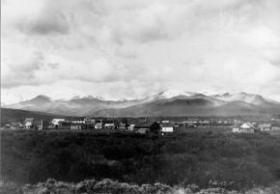Before the invention of seeding machines, a farmer or rancher would walk across his field in a straight line carrying a bucket or sack of seed with one hand. With his other hand he would fling fistfuls of fertile grain in a wide arc in front of his path. On reaching the end of the field, he would refill his bag, move over a few yards and repeat the process on the way back. After hours of walking and the casting of numerous sacks of seed, one handful at a time, the field would be planted.
I guess I was about 13 or maybe 14 when my father decided to plant timothy and clover on the east half of the meadow on the mesa. The area to be planted was probably forty acres or more that the ranch had leased to a Hindu man to grow lettuce and other truck crops. For several years we had gotten free lettuce for our table and our milk cows had loved the turnips from his harvest that were either too big or too small to be sold. I guess the profits from his work weren’t very good and the risk of growing lettuce in the rainy valley was too high. The Hindu had abandoned his lease and we would now put the water and the land to our own good use. Since we had no seeding equipment, we would broadcast the seed by hand. It would take hundreds of pounds of it to do the forty acres.
I was eager to help. Dad looked skeptical but finally agreed to let me try. After a bit of instruction he sent me off across the field. “Remember,” he had said. “You have to spread it even and don’t miss any spots.” I soon developed some regrets about volunteering. Not only did we have to plant the field once, but we had to plant it a second time as well. It seems that a planting of timothy and clover grows only a few inches high the first year and doesn’t produce a harvest. In order to avoid losing an entire season, it was customary to plant a second crop on top of it. In our case, Dad had chosen oats for the second planting. This choice would produce lots of feed right away even though the growing season in the Fraser Valley was too short to yield any grain. We planted the hay crop on one day and the oats the next.
I was exhausted by the time we had finished. In fact, if memory serves me right, Dad did the last five or ten acres by himself. When fall came, we had oats four feet high. They were cut, stacked like hay and fed out the following winter. The year after, there was beautiful timothy and clover that has continued to produce a fine crop for more than 60 years. When I visit friends on Ranch Creek every August, I drive by our field both coming and going.
Each time I see it, I remember my work and experience a sense of joy and accomplishment. All the things I produced over a professional career of nearly 40 years are now obsolete but the timothy and clover seeds planted so long ago are still growing. They will continue to do so until the Hurd Creek Ranch sells its water right and the field dries up. In our modern world, a 40-acre field of timothy and clover isn’t much. But how often, today, does a teen-ager have the opportunity to do work that will serve for a lifetime?
The above material is copyrighted by the author, Robert K. Peterson. Reproduction is any form is limited to the personal use of the view and/or to educational purposes. Neither the sale of nor any other commercial use of the text or illustrations is authorized.









